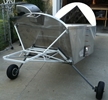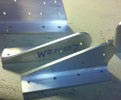


random user submitted photo
Sealing Exhaust
28 posts
• Page 2 of 3 • 1, 2, 3
Re: Sealing Exhaust
Hi paul, all,
Maybe david A. Can chime in on here . I'd love to borrow the tool when your done . Maybe we can pass it around like his oops tools. He's quite the machinest with nifty tools and solutions. And just an all around good guy to chat to. This is the first of this tool that ive heard about. Yes we tried the porsche muffler putty, didnt work too well. Red/copper rtv i dont think will last. This tool looks like a solution!
WaiexN143NM
Michael
Maybe david A. Can chime in on here . I'd love to borrow the tool when your done . Maybe we can pass it around like his oops tools. He's quite the machinest with nifty tools and solutions. And just an all around good guy to chat to. This is the first of this tool that ive heard about. Yes we tried the porsche muffler putty, didnt work too well. Red/copper rtv i dont think will last. This tool looks like a solution!
WaiexN143NM
Michael
- WaiexN143NM
- Posts: 1206
- Joined: Mon Sep 15, 2014 1:04 am
- Location: palm springs CA
Re: Sealing Exhaust
Hi Paul,
Interesting looking detector. I did a search to see what was available in Oz and came up with tools ranging in price from A$10 to A$820 including one apparently identical model that sold for $110 or $294 depending on where you bought it - the same model that Aircraft spruce sell as a "digital CO detector" for US$144.85 In Australia they are supposed to be calibrated annually which I imagine would cost more than the new price of many of the detectors. My wife recommended one of these:

Peter
Interesting looking detector. I did a search to see what was available in Oz and came up with tools ranging in price from A$10 to A$820 including one apparently identical model that sold for $110 or $294 depending on where you bought it - the same model that Aircraft spruce sell as a "digital CO detector" for US$144.85 In Australia they are supposed to be calibrated annually which I imagine would cost more than the new price of many of the detectors. My wife recommended one of these:

Peter
- peter anson
- Posts: 558
- Joined: Thu Jul 31, 2014 2:34 am
- Location: Mount Macedon, Australia
Re: Sealing Exhaust
Paul contacted me directly before I read this series in the digest. Sending out the tool tomorrow.
Improving that seal does greatly reduce the amount of black exhaust crud that gets inside the cowl, but i found most of my CO2 was coming in from the small holes in the tail and that plugging those with a couple of plastic snap caps made a big difference.
This reminds me that I seem to have lost track of who last had the oops fitting tools. No one has asked for them, but would be good to know where they are next time someone does need them.
David A.
Improving that seal does greatly reduce the amount of black exhaust crud that gets inside the cowl, but i found most of my CO2 was coming in from the small holes in the tail and that plugging those with a couple of plastic snap caps made a big difference.
This reminds me that I seem to have lost track of who last had the oops fitting tools. No one has asked for them, but would be good to know where they are next time someone does need them.
David A.
- DCASonex
- Posts: 935
- Joined: Mon Sep 12, 2011 8:04 pm
- Location: Western NY USA
Re: Sealing Exhaust
The CO2 is entering your cockpit from the rear fuselage. The shape of the canopy causes a negative pressure in the cockpit. On my Onex there is a big draft from the rear on each side of the seat. It's difficult to close all the openings back there. That's where the second notch on the canopy latch comes in handy. Open the canopy when you taxi and that kills the vacuum.
OneX 107
N2107X
N2107X
- Onex107
- Posts: 506
- Joined: Mon Mar 24, 2014 6:44 pm
- Location: Peoria, IL
Re: Sealing Exhaust
Sealing Exhaust Dilemma
When I attached the extension pipes to the Sonex factory exhaust for my Onex......I didn't like the loose fit with the tension springs that held everything together. Soooo.....I went with a very "low tech" solution, I simply used an auto exhaust pipe clamp ($2.49) and cranked it up tight. No more wiggle and it is a really tight fit with no leaks. You don't need RTV or anything else to make the seal..........(KISS)
Sometimes people tend to "over think" some of these issues.
Gordon.......Onex.......Hummel 2400
When I attached the extension pipes to the Sonex factory exhaust for my Onex......I didn't like the loose fit with the tension springs that held everything together. Soooo.....I went with a very "low tech" solution, I simply used an auto exhaust pipe clamp ($2.49) and cranked it up tight. No more wiggle and it is a really tight fit with no leaks. You don't need RTV or anything else to make the seal..........(KISS)
Sometimes people tend to "over think" some of these issues.
Gordon.......Onex.......Hummel 2400
- Gordon
- Posts: 178
- Joined: Thu Sep 07, 2017 9:20 pm
Re: Sealing Exhaust
OOPS TOOL
I have it. It’s been too cold to work, but plan to get the job done in the next couple of weeks.
PM me if you need it next.
Cheers, Gordon
I have it. It’s been too cold to work, but plan to get the job done in the next couple of weeks.
PM me if you need it next.
Cheers, Gordon
Waiex 158 New York. N88YX registered.
3.0 Liter Corvair built, run, and installed.
Garmin panel, Shorai LiFePo batteries.
3.0 Liter Corvair built, run, and installed.
Garmin panel, Shorai LiFePo batteries.
- GordonTurner
- Posts: 668
- Joined: Tue Feb 21, 2012 1:14 am
- Location: NY, NY
Re: Sealing Exhaust
Gordon Onex Hummel 2400,
I am not sure your solution with the automotive exhaust clamps will work. The exhaust extension pipes are designed to expand and contract. I suspect what will happen with the automotive clamps is that your exhaust will vibrate excessively and your exhaust manifold bolts in the heads will back out and perhaps also strip out the threads in the heads.
It is improbable that their is leakage in this joint area as the male end coming from the engine side plug into the female ends on the extensions.
Jake
I am not sure your solution with the automotive exhaust clamps will work. The exhaust extension pipes are designed to expand and contract. I suspect what will happen with the automotive clamps is that your exhaust will vibrate excessively and your exhaust manifold bolts in the heads will back out and perhaps also strip out the threads in the heads.
It is improbable that their is leakage in this joint area as the male end coming from the engine side plug into the female ends on the extensions.
Jake
Sonex Tri Gear, Rotax 912 ULS, Sensenich 3 Blade Ground Adjustable Propeller
MGL Velocity EMS, Garmin GTR 200 Comm, GTX 335 ADS B Out Transponder
ILevil AW AHRS & ADS-B In, UAvionix AV20S
200+ hours previously with Aerovee engine
Sarasota, Florida
MGL Velocity EMS, Garmin GTR 200 Comm, GTX 335 ADS B Out Transponder
ILevil AW AHRS & ADS-B In, UAvionix AV20S
200+ hours previously with Aerovee engine
Sarasota, Florida
-

SonexN76ET - Posts: 494
- Joined: Tue Aug 27, 2013 2:39 pm
- Location: Atlanta
Re: Sealing Exhaust
Below is slightly off topic, but does tie into sealing the exhaust.
------------------------------------------------------------------------
While awaiting the bead roller being delivered next week, I decided to try to use the CO detector to try to "sniff" various areas of the plane. I taped over the cabin heat thinking that to be the main source of the CO. It wasn't; guess that would have been too easy.
After checking the each area I was able to get the reading back down to single digits by holding the detector in front of my "fresh" air vent. Behind the seat in the "baggage" area, CO read about 25 PPM. Next to the wing root it was also around 25 PPM on the right, but would drop slightly on the left wing root (where the flap torque tube exits).
The highest CO PPM area appeared to be at the top of the canopy. Maybe CO floats? It also was around 35 PPM at the left-bottom side of the canopy where it meets the windscreen. If I made the mixture full rich I could get it to go over 50 PPM.
Below is a picture of the Digital CO meter next to the Chemical CO detector. If your chemical CO detector turns color, it's a serious situation. At 50 PPM, the number that the FAA AC says is hazardous, my Chemical CO detector didn't change.

------------------------------------------------------------------------
While awaiting the bead roller being delivered next week, I decided to try to use the CO detector to try to "sniff" various areas of the plane. I taped over the cabin heat thinking that to be the main source of the CO. It wasn't; guess that would have been too easy.
After checking the each area I was able to get the reading back down to single digits by holding the detector in front of my "fresh" air vent. Behind the seat in the "baggage" area, CO read about 25 PPM. Next to the wing root it was also around 25 PPM on the right, but would drop slightly on the left wing root (where the flap torque tube exits).
The highest CO PPM area appeared to be at the top of the canopy. Maybe CO floats? It also was around 35 PPM at the left-bottom side of the canopy where it meets the windscreen. If I made the mixture full rich I could get it to go over 50 PPM.
Below is a picture of the Digital CO meter next to the Chemical CO detector. If your chemical CO detector turns color, it's a serious situation. At 50 PPM, the number that the FAA AC says is hazardous, my Chemical CO detector didn't change.
Last edited by lpaaruule on Sat Feb 03, 2018 1:36 pm, edited 4 times in total.
Paul LaRue
Sonex N454EE Plans# 1509
Jabiru 3300
First Flight 12/21/2017
http://www.mykitlog.com/lpaaruule
Sonex N454EE Plans# 1509
Jabiru 3300
First Flight 12/21/2017
http://www.mykitlog.com/lpaaruule
-

lpaaruule - Posts: 233
- Joined: Wed Mar 26, 2014 6:33 pm
- Location: SE Michigan
Re: Sealing Exhaust
Hi Paul, Unfortunately, I can't see any pictures from your last post. Had a look at your build log and notice you have air outlets on each side of the engine cowl. I couldn't find any images of wing fitting, but if you don't have wing root seals, that could be the source of the CO.
Peter
Peter
- peter anson
- Posts: 558
- Joined: Thu Jul 31, 2014 2:34 am
- Location: Mount Macedon, Australia
Re: Sealing Exhaust
Hi Peter,
I think I have the picture link fixed.
As far as wing root seals, I don't have any, and you might be right about them being a source for CO. However, while investigating I did tape the wing roots, and also did a short run with the cowling air exits taped over, and this didn't clear up the problem. Perhaps I need to revisit that now that I have the firewall and cabin heat sealed tight.
I'm actually not sure how I'm going to seal the wing root as the gap is so small I doubt I squeeze anything in there. Maybe some caulking?
I think I have the picture link fixed.
As far as wing root seals, I don't have any, and you might be right about them being a source for CO. However, while investigating I did tape the wing roots, and also did a short run with the cowling air exits taped over, and this didn't clear up the problem. Perhaps I need to revisit that now that I have the firewall and cabin heat sealed tight.
I'm actually not sure how I'm going to seal the wing root as the gap is so small I doubt I squeeze anything in there. Maybe some caulking?
Paul LaRue
Sonex N454EE Plans# 1509
Jabiru 3300
First Flight 12/21/2017
http://www.mykitlog.com/lpaaruule
Sonex N454EE Plans# 1509
Jabiru 3300
First Flight 12/21/2017
http://www.mykitlog.com/lpaaruule
-

lpaaruule - Posts: 233
- Joined: Wed Mar 26, 2014 6:33 pm
- Location: SE Michigan
28 posts
• Page 2 of 3 • 1, 2, 3
Who is online
Users browsing this forum: No registered users and 18 guests







